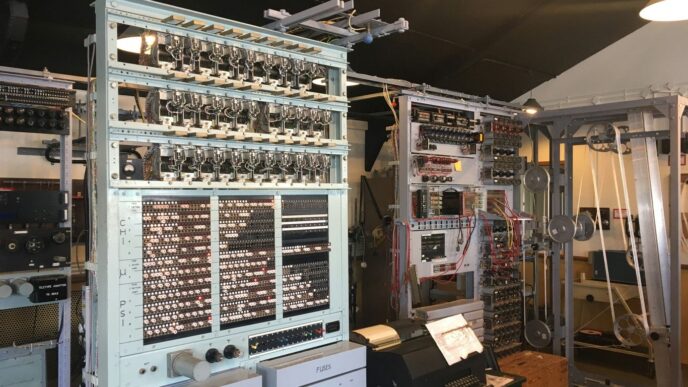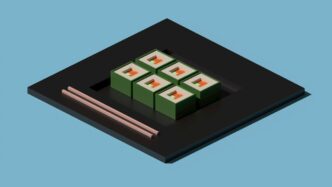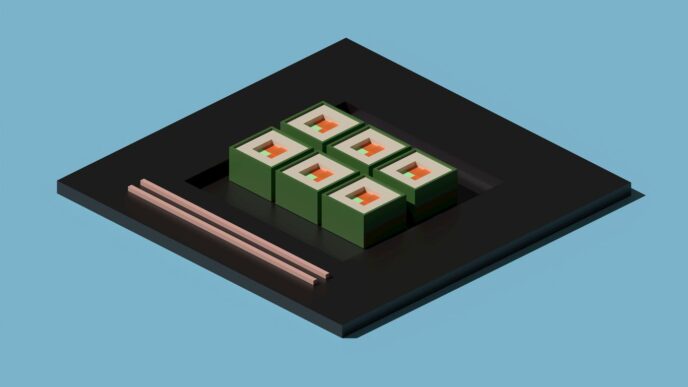The Dawn Of Quantum Computing
Foundations In Quantum Mechanics
So, quantum computing. It sounds like something straight out of science fiction, right? But it’s actually built on some pretty wild ideas from quantum mechanics, the science that looks at how really, really tiny things like atoms and subatomic particles behave. Unlike the stuff we see every day, these tiny particles don’t always play by the usual rules. They can be in multiple places at once, or be linked together in ways that seem impossible. This is the bedrock upon which quantum computers are being built. Understanding these strange quantum phenomena is the first step to grasping why these new computers could be so different.
Early Concepts And Pioneers
People started thinking about these ideas way back in the 1980s. Folks like Paul Benioff and Richard P. Feynman were asking questions like, ‘What if we could build a computer that uses these quantum rules?’ The main idea was that classical computers, the ones we use now, struggle with certain kinds of problems. As problems get bigger, the computing power needed grows super fast, like, exponentially. Quantum computers, on the other hand, are thought to handle this kind of exponential growth much better. It was a theoretical concept for a long time, a ‘what if’ scenario, but it planted the seed for what we’re seeing today.
The Promise Of Unprecedented Power
What’s the big deal then? Well, the promise is that quantum computers could solve problems that are practically impossible for even the most powerful supercomputers we have now. Think about simulating complex molecules for new drugs or materials, or breaking certain types of encryption that keep our data safe. These are problems where the number of possibilities is just astronomical. A quantum computer, by using those weird quantum properties, could potentially explore many possibilities at once. It’s not about just being a little faster; it’s about tackling entirely new classes of problems that are currently out of reach.
Navigating The Quantum Landscape

So, how do these quantum computers actually work? It’s not like your laptop, that’s for sure. Instead of bits that are either a 0 or a 1, quantum computers use something called qubits. These little guys are pretty wild because they can be a 0, a 1, or, get this, both at the same time. This is thanks to a quantum mechanics idea called superposition. It’s like flipping a coin and having it land on its edge – not something you see every day!
Then there’s entanglement. Imagine you have two qubits, and they’re linked. What happens to one instantly affects the other, no matter how far apart they are. Einstein famously called this ‘spooky action at a distance,’ and honestly, it still feels a bit like magic.
To actually do anything with these qubits, we use quantum gates. Think of them like the logic gates in regular computers, but for quantum stuff. They manipulate the qubits, performing operations to run quantum algorithms. Building these gates and arranging them into circuits is a whole field of study in itself. It’s a delicate dance, trying to keep everything stable while these operations happen.
Here’s a quick rundown of the key players:
- Qubits: The basic unit of quantum information. They can represent 0, 1, or a combination of both.
- Superposition: The ability of a qubit to exist in multiple states simultaneously.
- Entanglement: A connection between qubits where their fates are linked, regardless of distance.
- Quantum Gates: Operations that manipulate qubits to perform computations.
It’s a whole different way of thinking about computation, and honestly, it’s still pretty mind-bending stuff. But this is where the real power comes from.
Challenges In Quantum Advancement
Building these powerful quantum machines isn’t exactly a walk in the park. There are some pretty big hurdles we’re still trying to get over. It’s like trying to build a super-complex Lego castle during an earthquake – things tend to get a bit wobbly.
Qubit Stability And Error Correction
So, the basic building blocks of quantum computers are qubits. Unlike the bits in your laptop, which are either a 0 or a 1, qubits can be a 0, a 1, or both at the same time (that’s superposition, we’ll get to that). The problem is, qubits are incredibly fragile. They’re super sensitive to their surroundings – a tiny bit of heat, a stray magnetic field, or even just vibrations can mess them up. This loss of quantum state is called decoherence, and it happens really fast. When a qubit decoheres, it loses the quantum information it was holding, leading to errors in calculations. This is why keeping qubits stable, or ‘coherent’, for long enough to do useful work is a massive challenge.
To combat this, scientists are working on sophisticated error correction techniques. Think of it like having a really good proofreader for your calculations, but on a quantum level. These methods involve using multiple physical qubits to represent a single logical qubit, and constantly checking for and correcting errors. It’s complex, and it requires a lot more qubits than you’d initially think to get reliable results.
Scalability Hurdles
Even if we can make qubits stable and error-free, we need a lot of them to solve truly hard problems. We’re talking millions, maybe even billions, of qubits for some applications. Right now, the most advanced quantum computers have a few hundred, maybe a thousand, physical qubits. Scaling up is tough because as you add more qubits, the system becomes even more complex and harder to control. Imagine trying to manage a symphony orchestra where every musician is also trying to conduct – it gets chaotic fast.
There are a few ways people are trying to scale up:
- Modular Approaches: Building smaller quantum computers and connecting them together. This sounds promising, but connecting them without introducing more errors or losing speed is tricky.
- Improved Fabrication: Getting better at manufacturing the tiny components that make up quantum processors, similar to how semiconductor chips have gotten smaller and more powerful over the years.
- New Architectures: Designing entirely new ways to arrange and control qubits that are inherently more scalable.
The Noise Factor
Beyond decoherence, there’s also ‘noise’. This is a catch-all term for all the unwanted disturbances that can affect a quantum computation. It’s not just about the qubits themselves; it’s also about the control systems, the wiring, the environment – everything. This noise can introduce errors that are hard to distinguish from actual computational results. It’s like trying to listen to a quiet conversation in a crowded, noisy room. You might catch a few words, but the full message gets lost.
Dealing with noise often involves:
- Better Shielding: Physically isolating the quantum computer from external interference.
- Advanced Calibration: Regularly fine-tuning the equipment to minimize its own contribution to noise.
- Sophisticated Software: Developing algorithms that can account for and even compensate for certain types of noise.
These challenges are significant, but they’re also what make the field so exciting. Every breakthrough in overcoming these obstacles brings us closer to realizing the incredible potential of quantum computing.
Quantum Algorithms And Their Impact
So, what exactly can these quantum computers do that our current machines can’t? That’s where quantum algorithms come in. Think of them as the special recipes that tell a quantum computer how to tackle problems. They’re not just faster versions of old recipes; they’re entirely new ways of thinking about computation.
Solving Intractable Problems
Some problems are just too big, too complex for even the most powerful supercomputers we have today. They’d take longer than the age of the universe to solve. Quantum algorithms, however, can approach these problems differently. They can explore many possibilities at once, thanks to things like superposition and entanglement. This means problems that are practically impossible for classical computers might become solvable.
- Optimization: Finding the best solution from a huge number of options, like planning the most efficient delivery routes for a massive fleet of trucks.
- Simulation: Modeling complex systems, such as how molecules interact, which is super important for science.
- Search: Quickly finding specific items in massive, unsorted datasets.
Applications In Cryptography
This is a big one, and honestly, a bit scary. Many of the security systems we rely on today, like the ones that protect our online banking and private messages, are based on math problems that are really hard for classical computers to solve. Shor’s algorithm, a famous quantum algorithm, can break many of these encryption methods. This means we need to develop new, ‘quantum-resistant’ ways to keep our data safe before powerful quantum computers become widespread. It’s a race against time, really.
Drug Discovery And Material Science
Imagine being able to design new medicines or create revolutionary new materials from scratch. Quantum computers could make this a reality. By accurately simulating the behavior of atoms and molecules, scientists can predict how different substances will behave. This could lead to:
- Faster drug development: Identifying promising drug candidates much quicker.
- Novel materials: Creating materials with specific properties, like super-efficient solar cells or stronger, lighter alloys.
- Better catalysts: Designing catalysts that make industrial processes more efficient and less polluting.
It’s not just about speed; it’s about a completely new level of insight into the physical world.
The Symbiotic Relationship With Semiconductors
Semiconductor Technology’s Role
Semiconductors are the bedrock of pretty much all modern electronics, right? They’re those special materials that aren’t quite conductors and aren’t quite insulators, letting us control electrical flow. For decades, the industry has been all about making them smaller and smaller, packing more power into tinier spaces. Think about how much more powerful your phone is now compared to one from ten years ago. That’s largely thanks to advances in semiconductor manufacturing, pushing towards incredibly small fabrication processes like 5nm and even 3nm chips. This miniaturization isn’t just about making things smaller; it also makes them more energy-efficient. But it’s not just about silicon anymore. Researchers are looking into new materials like graphene and silicon carbide, which have some pretty neat properties. Plus, they’re developing new ways to build chips, like stacking them in 3D, to get around the limits of flat designs.
Synergies For Future Innovation
So, how does this all connect to quantum computing? Well, it turns out these two fields are starting to work together in some really interesting ways. Quantum computers need specialized chips, often made from things like superconducting circuits or trapped ions. As semiconductor tech gets better, it helps us build these quantum chips more efficiently and on a larger scale. This collaboration is key to making quantum computers more practical. It’s not just about quantum hardware, either. Quantum computing itself might help solve some really tough problems in designing new semiconductors or figuring out new materials. It’s a two-way street, with each field pushing the other forward.
Hybrid Quantum Systems
Looking ahead, we’re probably going to see a lot more hybrid systems. These are setups that combine regular, classical computers (the kind we use every day, built on semiconductor tech) with quantum processors. The idea is to use each type of computer for what it’s best at. Your classical computer can handle the routine tasks, while the quantum processor tackles the super complex problems that are impossible for current machines. This blend allows us to get the best of both worlds, optimizing performance for specific, demanding applications. It’s a smart way to start using quantum power without needing a fully quantum world just yet. It’s like having a super-specialized tool for the really hard jobs, while still using your trusty everyday tools for everything else.
The Pursuit Of Quantum Advantage
So, what’s the big deal with quantum computers actually being better than the ones we use every day? That’s where ‘quantum advantage’ comes in. It’s basically the point where a quantum machine can solve a problem that a regular, classical computer just can’t, or at least not in any reasonable amount of time. Think of it like trying to find a specific grain of sand on a beach – a classical computer might check each grain one by one, while a quantum computer could, in theory, check many at once.
Defining Quantum Supremacy
This term, ‘quantum supremacy’, gets thrown around a lot. It’s a bit like a benchmark. It means a quantum computer has done something, anything, that’s beyond the reach of even the most powerful supercomputers we have today. The catch? So far, the problems solved to show this ‘supremacy’ haven’t been particularly useful. It’s like building a super-fast race car that can only drive in circles in your backyard. Cool engineering, but not exactly changing the world yet.
Milestones And Current Progress
We’ve seen some exciting claims of quantum advantage recently. Companies and research labs are building these machines, and they’re getting bigger and more capable. However, there’s a big difference between a quantum computer that can do a specific, contrived task faster and one that can tackle real-world problems. Many current quantum computers have a few hundred qubits, which sounds like a lot, but they’re prone to errors. Think of them as early prototypes. Adiabatic quantum computers, which are designed for specific types of problems, have more qubits, but they haven’t yet shown a clear speedup for practical issues.
Here’s a rough idea of where things stand:
- Small-scale, Gated Quantum Computers: Available via cloud services, these are good for research but limited in scale.
- Adiabatic Quantum Computers: Have more qubits but are specialized for optimization tasks.
- Experimental Systems: Researchers are trying to link smaller quantum computers together, but this adds complexity and overhead.
Real-World Applications On The Horizon
While we’re not quite there yet for widespread use, the potential is huge. The first practical applications are likely to be in simulating physical systems. This could mean breakthroughs in:
- Drug Discovery: Designing new medicines by accurately modeling how molecules interact.
- Material Science: Creating new materials with specific properties, like better batteries or superconductors.
- Chemistry: Understanding complex chemical reactions that are too difficult to simulate classically.
These kinds of simulations often require fewer qubits than, say, breaking modern encryption, which is why they’re seen as a more achievable first step. The real game-changer, the kind of quantum computer that can solve massive computational problems, is probably still a decade or more away. But the progress is steady, and the race is on.
Looking Ahead
So, where does all this leave us? Quantum computing and the chips that power our world are both moving fast. There are still big hurdles to clear, like making quantum bits stable and shrinking computer parts even smaller. But the potential is huge. We’re talking about solving problems we can’t even touch right now, from creating new medicines to making better materials. It’s a complex field, for sure, but the progress we’re seeing suggests a future where these technologies work together, opening up new possibilities we’re only just starting to imagine. It’s going to be an interesting ride watching how it all unfolds.














